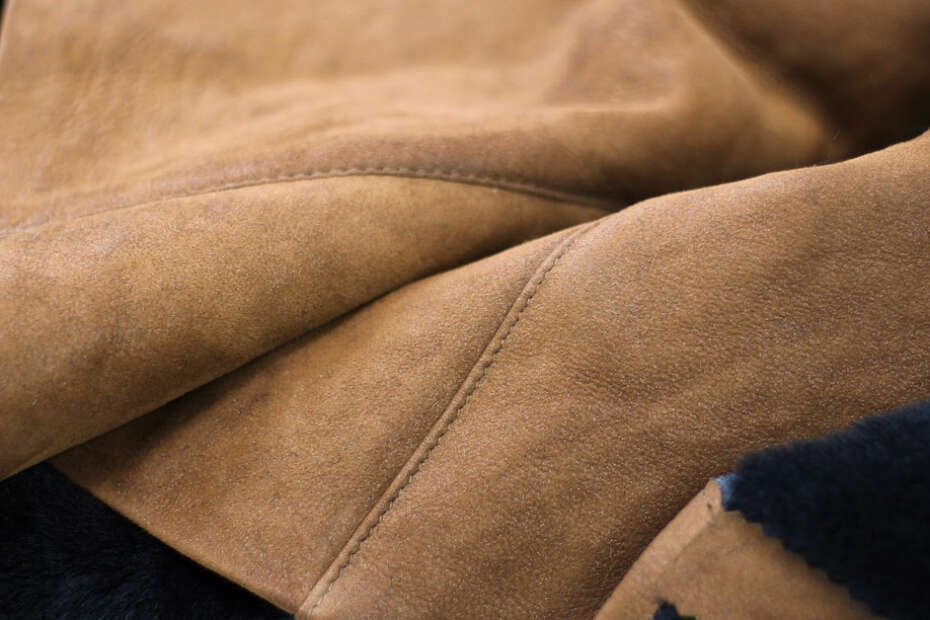Leather jackets have been around forever, and they’re not going anywhere. From timeless classics to modern interpretations, they’re an essential part of any winter wardrobe. The thrill of adding a new one into your collection is definitely unmatched.
But wait, the newest leather jacket you bought is not as soft as you wanted it to be. Instead, it’s stiff and uncomfortable. You love the design, but it hurts to wear it. Well, leather jackets can feel rigid if they aren’t worn often— especially the first time.
The pliability and softness of the leather jacket are fairly dependent on the source of the hide its leather is made from. For instance, cowhide leather is the most durable, toughest, and heaviest is not as soft as goatskin or sheepskin leather.
There are a handful of other factors that contribute to the stiffness of a leather jacket. So what can you do about it? This blog post will show you how to soften a leather jacket. Follow these tips, and your leather jacket will feel like butter on you.
What To Expect In This Article?
Why Does A Leather Jacket Lose Its Softness?

The quality of a leather jacket is determined by multiple factors. But even when your leather jacket quality is high, it can still lose its softness and you will feel uneasy wearing it. A variety of conditions could be to blame, and understanding them will help you be proactive about protecting your favorite leather jacket.
Grade of Leather Matters
Shopping for a leather jacket is a huge undertaking, especially when you’re buying it for the first time. If you want your jacket to be soft and long-lasting, look into the grade of the leather. High-quality leather jackets are usually made from full-grain leather, a type of leather that’s softer in texture and sturdier in quality.
To check if a jacket’s leather is full-grain or not, have a look at its surface. Full-grain leather has all the unique patterns and imperfections intact, which are sanded in top-grain leather.
Inappropriate Storing Environment

The way you store a leather jacket has the utmost importance in keeping it soft and supple. First of all, low and high humidity can both cause damage to the leather.
Prolonged exposure to moisture can harden up the leather, and if the environment is too dry, it will squeeze out the moisture content from the leather making it stiff— so make sure you store your jacket in an environment with moderate humidity. The ideal range is between 40% t0 50%.
Read the label of your product to know more about how to store it, and if you are still unsure, you can also get it professionally stored at a local cleaner.
Wearing A Size Too Small

Choosing a leather jacket that is too tight for your size not only ruins the overall aesthetic of your leather jacket outfit, but it also might not be better in the long run.
Keep in mind that leather jackets are more likely to experience stretching when they are too tight. The stretching will lead to a stiffer texture, and you will feel that the jacket is not as soft and supple as you want it to be.
That being said, sizing up your leather jacket is also not recommended as real leather tends to loosen up with use.
Tumble Drying The Leather Jacket

A good-quality leather jacket will not be very gentle on your pocket, so you don’t want to ruin your investment by incorrectly drying it. No matter how wet your leather jacket has gotten, drying it in a tumble dryer is never an option.
The heat and fast spinning of a dryer can dry out leather leading to a stiff and uncomfortable leather jacket. Not only this, the jacket will also likely develop irremovable creases and wrinkles.
We recommend putting it in a cool, dry place and allowing it to air dry before storing it in the closet.
Age of The Leather Jacket

Leather is undoubtedly a durable material, and if cared for properly, your leather jacket will last for years and age gracefully; however, like any other clothing item, you have to say goodbye to it at some point.
With proper conditioning, right storage, and cleaning, the best of the best leather jackets can last for almost more than a decade without losing their softness and comfort.
However, a very old leather jacket will no longer sustain its softness which is unlikely to be restored as the jacket has served you well. So it’s time to get a new one that offers the desired flexibility and softness.
How To Soften A Leather Jacket- Five Easy Ways!
1. Wear The Leather Jacket Regularly
When it’s new, a leather jacket can be stiff and uncomfortable, but wearing it often will make your new piece soft and more comfortable. For example, put it on while walking around the house and perform some physical activity or motions to speed up the softening process.
If your used leather jacket has been just sitting in your closet for months, especially in summer, it might also become too stiff to wear comfortably. So in the summer and spring, wear your jacket every few weeks to ensure that it’s soft and elegant when the winter sets in.
2. Spritz The Leather Jacket With Water
A stiff leather jacket won’t become an extension of you and can be a real nuisance to deal with. So, how to soften a leather jacket? First, you could try using water, which is an age-old trick for softening leather. At least a method that many swear by online.
It may seem counter-intuitive, but lightly misting your leather jacket with water is actually good to make it soft. Not only does it soften and mold the fabric to your body more comfortably, but it also helps remove wrinkles and creases.
It’s best to keep the jacket on after misting it with water. This way, it will mold your body better. Never store it when it’s wet. Instead, allow it to dry naturally before storing.
Be informed that this method will not work if you have used any spray protectant or a waterproofing solution on your leather jacket.
3. Apply Oil On The Leather Jacket
When leather isn’t well moisturized, it dries up, which makes it stiff, uncomfortable, and brittle. A small number of natural lubricants like oil can make it move again, giving it a lovely softness.
Oils are also a cheaper and readily available alternative to leather conditioners that can help you maintain and preserve your leather jacket’s softness.
You can use many different types of oils for this purpose. However, the most commonly used and safe-to-use oils found online are castor oil, mink oil, neatsfoot oil, and coconut oil.
To get the best results, apply mink oil with a soft cloth in a circular motion until fully absorbed. Repeat this treatment multiple times until you get the desired results.
4. Use A Leather Conditioner
Leather conditioners are a must-have if you want to keep your leather goods looking their best. There are creams, sprays, and balms available in the market, all with the goal to soften, protect, and nourish the leather.
Even if your leather jacket isn’t becoming stiff, it will still benefit from a quick conditioning session. So don’t hesitate to apply a good quality conditioner at least twice a year to make your jacket feel better and soft.
Before applying any sort of conditioner on your leather jacket, clean the leather jacket. Any dirt or dust should be removed. Then pour a suitable amount of conditioner on the jacket.
With a cotton cloth or applicator sponge, rub the conditioner on the jacket until the material entirely absorbs it. This will soften the leather, and it’ll have that cozy feel you’re after sooner than if you didn’t.
5. Rub Alcohol & Petroleum Jelly
The softness of a leather jacket can be enhanced with a healthy application of rubbing alcohol and petroleum jelly. The alcohol will remove the dirt and grime and penetrate into the leather fibers to loosen it up. Petroleum jelly will keep the leather soft and supple. Here’s how to perform this method
Dip the cotton pad in rubbing alcohol and wipe down the leather surface. It should become shiny — if not, add more alcohol to the cotton pad. Wait for the alcohol
to evaporate.
Afterward, immediately apply petroleum to the surface. You should be able to tell when it’s time to stop, but you can use a few layers if you feel that leather can absorb more. Leave it to dry overnight and wake up to a buttery soft leather jacket.
F.A.Qs
Yes, you can use oil like baby oil on faux leather to enhance its shine. However, it will not do anything to improve its softness. Faux leather is non-porous, so the oil will stay on the surface and not get absorbed, unlike real leather. To maintain and soften faux leather jackets, use a vinyl conditioner.
You can use an assortment of natural oils on leather to condition and soften the leather. The cheapest option is castor oil and readily available in grocery stores and pharmacies.
You can also use coconut oil, olive oil, and also almond oil, depending on the availability. However, coconut oil leaves a sticky residue on the leather surface, and olive oil might stain your favorite leather jacket.
The most efficient options with little to no side effects and better leather-softening effects are mink oil and neatsfoot oil. But neatsfoot oil has some limitations too. Being inherently acidic in nature, it can rot the cotton stitching on your leather products.
Mink oil poses no such problems and is considered the safest and most effective of all with high permeability and leather-softening effects.
The leather becomes softer with use regardless of what type of animal skin it is made from. However, you can achieve a supple feel quicker by using a variety of methods, from wearing it more often to lightly spraying it with water to conditioning it with natural oils.
Saddle soap is a popular choice for cleaning leather goods. Therefore you can use it to remove dirt, grease, and other unwanted substances from your leather jackets. However, it doesn’t do much to soften them.
Wrapping Up
With the winter cold in full swing, we all want to wear our leather jackets without compromising on comfort. Keep all the dryness and stiffness at bay by avoiding the things that cause them in the first place. But if it happens, you can always leverage any of the above-mentioned methods to restore suppleness, be it using a leather conditioner or softening them with suitable oil, or going for professional care, if you’re not comfortable trying the above-mentioned tips that many have tried online. Be sure to treat this outerwear with a bit of love by choosing the best quality products.




